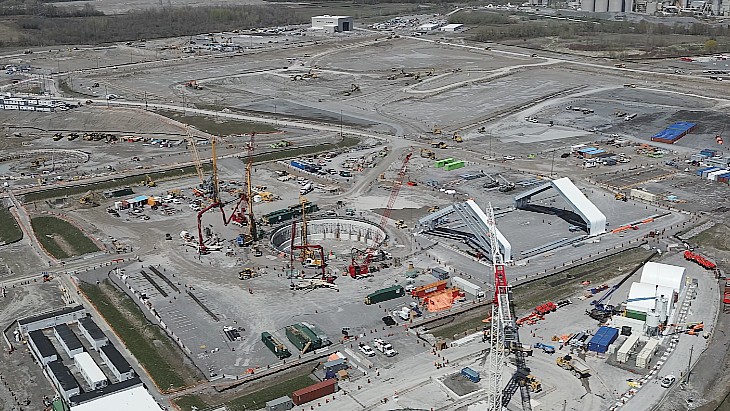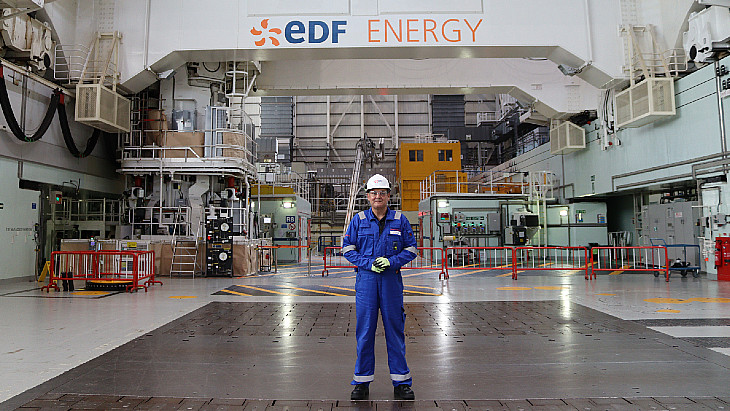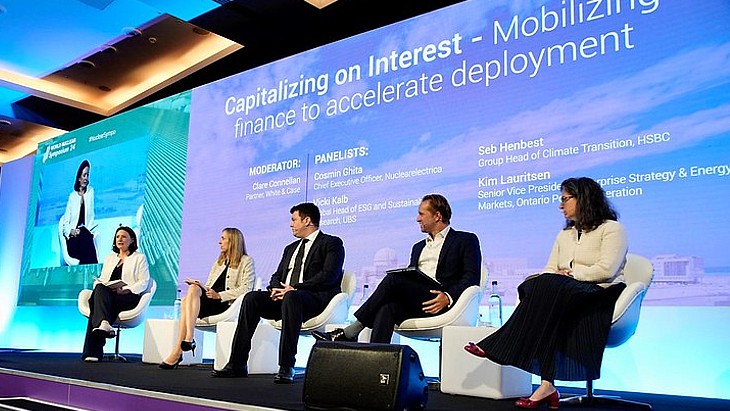The Moorside and Wylfa Newydd projects, each of which received hundreds of millions of pounds of private sector development costs, were respectively abandoned and put on hold due to lack of government support. Aside from recognising the role nuclear has to play in a Net Zero energy mix, the most obvious gap is a decision on a new build funding model.
Nuclear is disparaged among detractors for its cost. The reference point for new build nuclear is generally cited as Hinkley Point C's 2016 strike price of GBP92.50 MWh (if Sizewell C is not also developed) and compared to the most recent GBP39.65 MWh strike price for offshore wind. However, this argument conveniently omits that the strike price for offshore wind in the first round Contract for Difference (CfD) auction in 2015 was close to GBP120 MWh.
Proponents of nuclear note that such 'point of time' price statements are rarely insightful, and that analyses should focus on total system cost, which weighs investment against the contribution of each technology to low-carbon reliable power supply.
As things stand, UK nuclear capacity in 2050 will be just a third of what it is today, with the Hinkley Point C plant in Somerset (two reactors with an output of 3.2GW) remaining as the UK's only nuclear power station. This will put significant pressure on flexible gas-fired generation (to supplement intermittent wind and solar), which will only be available if carbon capture and storage has proved commercially viable at scale, as the sole other provider of "firm low-carbon power" identified by the Committee on Climate Change (CCC) in its 2019 Net Zero report.
There is reluctance to acknowledge that Net Zero involves nuclear power in a 2050 energy mix. But time is ticking and the UK government is rapidly running out of private sector partners to join its nuclear strategy, with RWE, Eon, Centrica, GDF Suez, Toshiba and (possibly) Hitachi having given up their UK nuclear new build aspirations.
That leaves EDF and China General Nuclear (CGN) as the only potential developers of large scale (Gen III+) nuclear in the UK. EDF has said the window of opportunity for transferring its development capability from Hinkley Point C to Sizewell C in Suffolk is rapidly diminishing, while CGN's continued investment in Sizewell C (and ownership of the Bradwell B project in Essex) has come in for unfavourable attention as part of the Huawei political fall-out.
Nuclear is perhaps the archetypal low-carbon, provider of baseload electricity, as it has a low marginal cost of generation.
UK's nuclear foundation
Nuclear provided 25% of UK energy generation in the late 1990s, but that figure hovers around 18% today (c.9GW of capacity). The generation mix has changed markedly over that period, but even over the last couple of years nuclear output has fallen as a number of prolonged outages has affected the availability of the incumbent advanced gas-cooled reactor (AGR) fleet. This trend is likely to continue as they approach their final operating years.
EDF's seven AGR stations are expected to close by 2030 and its single pressurised water reactor (PWR), Sizewell B, is expected to close at some point in the 2040s.
In its Net Zero report, the CCC recognised the role low-carbon power (particularly nuclear) can play in complementing renewable generation, rather than assuming that renewables will rapidly displace all other forms of generation.
The CCC believes variable renewables will contribute up to 57% of the total power mix, and that 38% will come from 'firm' sources like nuclear or gas with carbon capture.
The CCC's 38% firm power share assumes a contribution of around 10GW of nuclear or roughly equivalent to the UK's capacity today. This is based on the projected replacement of the current fleet with three larger plants (Hinkley Point C, Sizewell C and Bradwell B - although EDF recently announced a proposal to deploy its EPR reactor at Moorside near the abandoned NuGen site in Cumbria). It could also be a combination of large projects with small modular reactors (SMRs) or advanced modular reactors (AMRs), and indeed the contribution of nuclear could be more than 10GW if the capacity of gas with carbon capture turned out to be lower than anticipated.
Key determinants of nuclear's capacity contribution will be how quickly carbon capture is proved viable at scale (to allow use of natural gas in "blue" hydrogen production), and how quickly other solutions to high levels of intermittency emerge (e.g. synthetic inertia, longer-term storage and frequency moderation technology).
The UK government has also dragged its feet in announcing how it intends to deliver its renewable power targets, such as 40GW of offshore wind by 2030. Failing to ramp up renewable capacity in time will place more pressure on nuclear.
The Nuclear Industry Association (NIA) recently announced its ambition to maintain nuclear's 40% share of clean electricity in 2050, with strong support for Sizewell C, Horizon's ABWR Wylfa project in Anglesey and Oldbury project in Gloucestershire, and CGN's HPR1000 Bradwell B project.
The NIA also advocated a significant build programme of SMRs and AMRs, emphasising that these could be co-located on existing sites, giving rise to co-licencing and operating cost synergies. In total, this could provide generating capacity of well over 30GW.
The Energy System Catapult released a report in June, Nuclear for Net Zero, concluding that an initial commitment to a programme of 10GW additional large scale capacity (beyond Hinkley Point C) would be a decision of low or no regret, provided construction duration and costs continue to reduce in line with its modelling.
This preserves the option of accelerating the rollout of UK light water SMRs and Generation IV technology (AMRs), by enabling assessments of development routes at points down the road. It found that scenarios which exclude new nuclear entirely place the system under enormous stress, with associated significant cost and land use implications.
Securing the required cost reductions for nuclear depends on committing to a programme of projects, rather than individual unconnected projects. Although it goes against the grain of the industry's inclusive approach, this suggests a winner will need to be picked from the various reactor types currently being licenced by the Office for Nuclear Regulation.
The capital cost of nuclear
The cost of capital currently represents anywhere from half to two-thirds of a nuclear project, far exceeding the actual cost of construction (and carrying a very heavy risk-adjusted view of the delivery profile of nuclear projects).
The NIA claims that a GBP1 billion reduction in construction cost (around 5-7% of the total) would take around GBP2-3 MWh off the cost of the project, while a mere 1% reduction in cost of capital would save GBP8-9 MWh. Projected cost savings depend on construction methods and funding models, but the nuclear industry believes ~GBP60 MWh is achievable for the next wave of plants, reducing to around GBP40/MWh for subsequent units and that a LCOE range as low as GBP30 MWh could be possible with full government funding, rising to GBP60 MWh with a Regulated Asset Base (RAB) model.
The pause since the government launched its RAB consultation in July 2019 suggests it is not yet comfortable that RAB is the perfect funding model for delivering new build nuclear.
One of the National Audit Office's criticisms of Hinkley Point C’s CfD is the attitude to risk allocation. By allocating key project risks to government (e.g. construction cost overrun above a threshold, regulatory and political risk, uninsurable risks and disruption to debt markets), a RAB model should encourage a wider range of funds to come forward on a more de-risked (and so, cheaper) basis.
A RAB model also has a more attractive payment profile. CfD-supported projects only receive revenue payments on successful commissioning. This means upfront development and construction costs have to be funded entirely by the developer and its investors.
A RAB model is thought to be cheaper because it enables earlier payments to be made to the developer, generally in line with actual construction of the project. This significantly decreases the cost of capital (because cheaper debt should be available in higher volumes), and the revenue allows earlier repayment of debt, limiting the impact of compound interest and costs associated with delays to equity returns.
Hinkley Point C will probably be the last conventional nuclear power station developed in the UK. New plants (large or small) will be designed to capitalise on 'waste heat' from reactors by using it for highly efficient district heating schemes for domestic and commercial spaces, water heating and for industrial processes. With around 20% of UK emissions associated with residential heating, there is clear potential for nuclear to provide heat for local decarbonised heating systems.
New build nuclear also has the potential to co-locate electricity storage projects and electrolysers (for the production of hydrogen) on or near nuclear sites, to capitalise from the regular generation profile, land availability and grid connectivity. This will allow them to become much more incorporated into local energy systems, rather than being remote outliers.
Without commitment from government, there will be no incentive to stimulate private sector investment in new capacity or continue to find ways of reducing the cost of capital.
Hugo Lidbetter






_88592.jpg)




